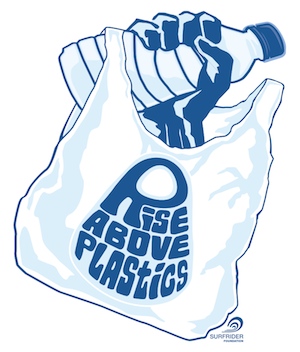
by Taylor Bratton, Rise Above Plastics volunteer
https://youtu.be/GESHrgygd2Q
Video produced by Eliette Singleton
Plastic has taken over the shelves in our grocery stores. The EPA estimates that plastic packaging makes up a quarter of all landfill waste, most of it from food products. If you want to reduce the amount of plastic polluting our lands and oceans, you’ve come to the right place.
My personal journey with zero-waste began with omitting straws and plastic bags from my daily life. Then I thought, why stop there? I noticed that most single-use plastic waste in my house came from food products.
When I started plastic-free shopping, I realized that it would take some practice. I had to figure out how to replace many of the things I often buy in convenient containers, and I had to remember all my bags and jars when I went to the store. The most important thing I learned is that any effort is good effort. Just being aware of how much plastic comes through your life is progress. The fight against plastic isn’t about being perfect, it’s about doing better.
Here is a list of tips to navigate the grocery store with zero-waste in mind:
- Bring your bags!
In the US alone, 380 billion plastic bags and wraps are used per year. Many of these end up in waterways and the thin plastic cannot be recycled in curbside bins.
Another thing to note is that some stores are currently hesitant to allow reusable bags due to health concerns. We are now allowed to bring our own bags again, but if a store says differently, there are two options. First, you can offer to bag your own groceries. Second, you can always put the groceries back into your cart and take them directly to your car – sans plastic bag.

No more single-use bags!
- Shop the Perimeter of the store
I gleaned this tip from Michael Pollan, the author of the Omnivores Dilemma. He states that by shopping on the outer edges of the grocery store, you can avoid packaged and unhealthy food in the inner aisles. His advice is more health-oriented, but it works for avoiding plastic too. The perimeter is generally where you find the produce, fresh cheeses and meats. Want potato chips? Get potatoes from the produce section and make them at home!
- Bulk Bins
Shopping in bulk is the ultimate plastic free hack. This is how I would get staples like rice, beans, flour and nuts – pre-Covid. Right now, most bulk sections are closed so I’ve had to get creative.
Before the bulk bins were down for the count, I would always bring a few glass jars or small canvas bags to the store. The first time you use the jars, take them to the cashier and ask them to weigh them. That way you can subtract the weight of the jar from your food when you check out. You can do this at home too if you have a kitchen scale. I usually write the tare weight on the jar in sharpie so I know how much they should subtract.
When you use bulk bins, the standard is to write the PLU number on a little twist tie and use it to seal up your plastic bag. These little strips of plastic don’t work very well to label a jar. My preferred way to indicate what’s in my jar at checkout is by writing the number on the lid in dry erase marker. If I happen to forget my marker, I just take a picture of the number.

Naked produce and reusable bulk bags, alert the media!
- Get Creative!
Getting loose produce is the easiest way to skip a plastic bag. I throw avocados and apples straight into my cart and the world hasn’t ended yet! If you’re really into keeping your produce together, there are tons of options for reusable mesh produce bags online.
Cheese is usually tricky to get without plastic. I don’t eat much cheese, but when I do I opt for ones wrapped in wax paper. Cowgirl Creamery is on the expensive side, but it’s plastic free and worth the splurge. When we’re not in a pandemic, sometimes I bring a glass Tupperware to the deli and ask them to put some fresh cheese in it for me.
Milk cartons are deceiving. They look like they’re made of cardboard, but they have a plastic film hidden inside. I started making my own nut (and oat) milks years ago and I haven’t looked back. Here is a link to the most life changing recipe.
It’s possible to find most food in alternative packaging. I go for beans in aluminum cans, pasta sauces and salsas in glass jars, and fresh bread in paper bags.
Hot tip: farmers markets are a great place to look for plastic free foods! Plus you get to support local farmers and eat delicious fresh food that’s in season. Click Here to find them in San Diego County.
